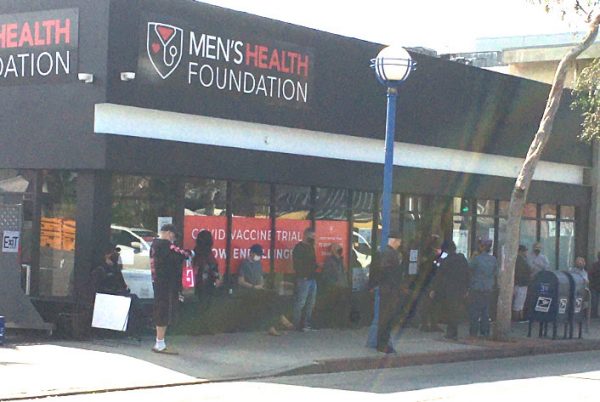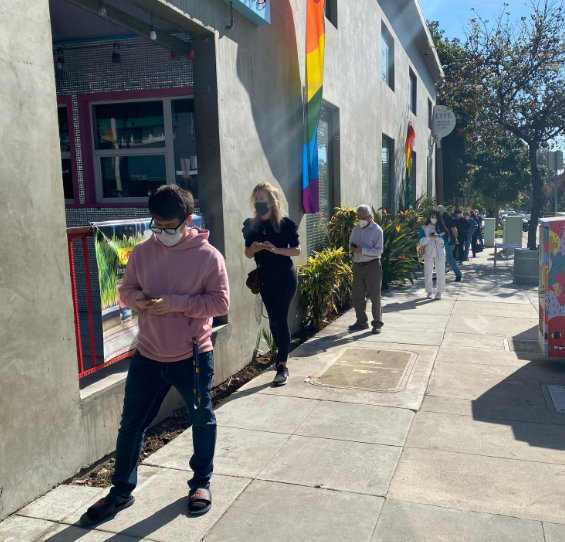
Lines are long at vaccination sites all across Los Angeles County. West Hollywood residents have been witnessing that on a daily basis as the queue to receive vaccinations at the Men’s Health Foundation location at 8280 Santa Monica Blvd. has stretched down the block and around the corner onto Sweetzer Avenue.
County health officials say only a fraction of residents aged 65 and over have received a COVID-19 vaccine and supplies of the medication remain woefully low.
The county is only receiving about 200,000 doses of the vaccine per week. In fact, the mass vaccination site at Dodger Stadium will be closed on Friday and Saturday because they will have already administered all the vaccine they have for the week by the end of the day on Thursday.
Officials hope to reopen the Dodger Stadium vaccination site on Tuesday or Wednesday, depending on when the next shipment of the vaccine arrives, according to Los Angeles Mayor Eric Garcetti.
Even as the people currently eligible to receive the vaccine are awaiting vaccination, Los Angeles County plans to the expand the number of people eligible in the next two to three weeks.
Public health director Barbara Ferrer said Wednesday they plan to open vaccination to an array of essential workers including teachers by the end of February.
The move follows a call by Gov. Gavin Newsom in late January for shots to be offered to essential workers in three categories: education/child care; food and agriculture; and emergency services and law enforcement.
In Los Angeles County, those categories represent roughly 1.3 million people, meaning that even after they become eligible for the shots, it will take weeks to get all of them fully vaccinated, which requires two doses spaced out by three to four weeks.

With vaccine supply remaining low and the field of eligible residents expanding, getting an appointment for a shot which is already difficult will likely get even more difficult.
The expansion of the vaccine eligibility will occur even as the county continues administering shots to the currently eligible populations — health care workers, residents and staff of nursing and long-term care facilities and residents 65 and over.
Public Health Director Barbara Ferrer noted that to date, only 20% of residents aged 65 and over have received at least one dose of the medication.
“At this point, we’d like to make significant inroads into getting people who are older vaccinated,” Ferrer said. “… Our hope is that over these next two weeks you’re going to see that number go way up in terms of the number of older people who are getting vaccinated. But also it’s an acknowledgement that we do have to get started with some of our essential workers. It’s gonna be really difficult to wait weeks and weeks and weeks until we complete an entire sector before we move on.”
According to the county Department of Public Health, the county has received more than 1.28 million doses of the vaccine as of Feb. 4, and more than 1.05 million doses — about 82% — have been administered.
But breaking down the ethnicity of the people who have received at least one dose shows major disparity:
- 25% White
- 25% Hispanic
- 18% Asian
- 3.5% Black
“Shockingly, Black residents have received only 3.5% of all administered doses, highlighting a glaring inadequacy in the vaccine rollout to date,” Ferrer said.
Looking at residents aged 65 and over who are eligible to receive the shots, “Black residents have the lowest vaccination rate of all racial and ethnic groups at 7.2%, and this is less than half the rate of white residents and a third the rate of Pacific Islanders,” Ferrer said.
“In the Latinx community, which has experienced the highest case, hospitalization and death rates, only 14% of Latinx residents (aged 65 or older) have been vaccinated to date,” she said.
Ferrer said health officials are “alarmed” by the disproportionate numbers, and closing those gaps “is a top priority” for the health agency.
“We’re going to continue to work with our community partners to ensure that we’re not only getting everyone vaccinated quickly, but we’re addressing the need to provide easier access to neighborhood sites and better access to accurate information about the vaccines,” she said.
County Supervisor Hilda Solis said she was distressed by the numbers, which she said show “we still have a lot more work to do.”
“This is completely unacceptable, and we will be sharing some of those changes in our vaccine rollout in the coming days to ensure that it is truly equitable,” Solis said. “Frankly, I’m disappointed, and I’m calling on all of us — our departments and our medical providers — to fulfill their responsibility to ensure that the vaccine gets to those who need it the most.”
City News Service contributed information for this story.
